Stochastic Optimization Operation of the Integrated Energy System Based on a Novel Scenario Generation Method
Abstract
:1. Introduction
2. Scenario Generation Method
2.1. Time-Divided Probability Distribution Model of Forecasting Error
2.2. Multivariate Standard Normal Distribution
2.3. Covariance Parameter Optimization
3. Stochastic Optimization Operation Model of an Integrated Energy Microgrid
3.1. Optimization Model of Operation Cost
3.2. Expected Model of Operating Cost
3.3. Solving Method and Steps
4. The Results and Analysis
4.1. Probability Distribution Model
4.2. The Analysis of the Time Correlation
4.3. Optimized Operation of Integrated Energy Microgrid
5. Conclusions
Author Contributions
Funding
Institutional Review Board Statement
Informed Consent Statement
Data Availability Statement
Acknowledgments
Conflicts of Interest
Abbreviations
| PV | Photovoltaic |
| IES | Integrated energy system |
| IEMG | Integrated energy microgrid |
| TOU | Time-of-use |
| NSGA-II | Non-dominated Sorting Genetic Algorithm II |
| SoC | State of charge |
| RMSE | Root mean square error |
| NKDD | Nonparametric kernel density distribution |
| PDC | Probability density curve |
| Symbol (Unit) | Symbol Meaning |
| The sample point (e.g., PV power) of independent identical distribution . | |
| The probability density function. | |
| The bandwidth. | |
| The sample number. | |
| The kernel function. | |
| is the scenario can be viewed as a random vector. | |
| (h) | Time |
| The covariance matrix. | |
| The covariance between and , . | |
| The scaling factor | |
| The exponent that is assumed to be a positive integer. | |
| The probability distribution function of real data. | |
| The probability distribution function of the generated data. | |
| (kW) | The power fluctuation of real data. |
| (kW) | The power fluctuation of generated data. |
| (kW) | The value of random variables. |
| (kW) | The forecasting value. |
| (kW) | The value of the forecasting error. |
| (CNY/kWh) | The electricity price. |
| (CNY/m3) | The natural gas price. |
| (CNY/kWh) | The price of selling electricity to the grid. |
| (CNY) | The cost of purchasing electricity from the power grid. |
| (CNY) | The cost of purchasing gas. |
| (CNY) | The operating income is from selling electricity to the power grid. |
| (kW) | The power purchased from the grid. |
| (kWh) | The heating energy of the gas microturbine. |
| (kWh) | The heating energy of the gas boiler. |
| (kWh/m3) | The natural gas heating value. |
| (kW) | The power sold to the grid. |
| The coefficient of performance of the absorption chiller. | |
| The coefficient of performance of the electric chiller. | |
| (kW) | The heating power is input into the absorption chiller. |
| (kW) | The electric power input into the electric chiller. |
| (kW) | The cooling power of load. |
| (kW) | The heating power absorbed by the waste heat recovery device. |
| (kW) | The heating power generated by the gas boiler. |
| (kW) | The heating power input to the absorption chiller. |
| (kW) | The charging heating power of the thermal storage tank. |
| (kW) | The discharging heating power of the thermal storage tank. |
| (kW) | The heating load. |
| The efficiency of the heating exchanger. | |
| (kW) | The gas microturbine output power. |
| (kW) | The power purchased from the grid. |
| (kW) | The input electric power of the electric chiller. |
| (kW) | The charging power of the battery. |
| (kW) | The discharging power of the battery. |
| (kW) | The power sold to the grid. |
| (kW) | The electric load. |
| (kW) | The PV power. |
| (kW) | The wind power. |
| The efficiency of the gas microturbine. | |
| (kW) | The minimum values of the gas microturbine power. |
| (kW) | The maximum values of the gas microturbine power. |
| The state of charge of the battery. | |
| The charging efficiency. | |
| The discharging efficiency. | |
| (kWh) | The rated energy of the battery. |
| (kW) | The maximum power. |
| The minimum SoC. | |
| The maximum SoC. | |
| The 0–1 variable related to the battery. | |
| (kW) | The maximum interactive power. |
| The 0–1 variable related to the interactive electric power. | |
| (kWh) | The heating energy stored in the thermal storage tank. |
| The charging efficiencies of the thermal storage tank. | |
| The discharging efficiencies of the thermal storage tank. | |
| (kW) | The charging heating power. |
| (kW) | The discharging heating power. |
| (kW) | The maximum heating power. |
| (kWh) | The minimum heating energy. |
| (kWh) | The maximum heating energy. |
| The 0–1 variable related to the thermal storage tank. | |
| The probability of scenario. |
References
- Chen, Y.; Deng, C.; Yao, W.; Liang, N.; Xia, P.; Cao, P.; Dong, Y.; Zhang, Y.-A.; Liu, Z.; Li, D.; et al. Impacts of stochastic forecast errors of renewable energy generation and load demands on microgrid operation. Renew. Energy 2019, 133, 442–461. [Google Scholar] [CrossRef]
- Zakernezhad, H.; Nazar, M.S.; Shafie-Khah, M.; Catalão, J.P. Optimal resilient operation of multi-carrier energy systems in electricity markets considering distributed energy resource aggregators. Appl. Energy 2021, 299, 117271. [Google Scholar] [CrossRef]
- Yang, Z.; Wu, R.; Yang, J.; Long, K.; You, P. Economical Operation of Microgrid with Various Devices Via Distributed Optimization. IEEE Trans. Smart Grid 2015, 7, 857–867. [Google Scholar] [CrossRef]
- Gan, W.; Yan, M.; Yao, W.; Guo, J.; Ai, X.; Fang, J.; Wen, J. Decentralized computation method for robust operation of multi-area joint regional-district integrated energy systems with uncertain wind power. Appl. Energy 2021, 298, 117280. [Google Scholar] [CrossRef]
- Marino, C.; Marufuzzaman, M.; Hu, M.; Sarder, M. Developing a CCHP-microgrid operation decision model under uncertainty. Comput. Ind. Eng. 2018, 115, 354–367. [Google Scholar] [CrossRef]
- Wang, Q.; Liu, J.; Hu, Y.; Zhang, X. Optimal Operation Strategy of Multi-Energy Complementary Distributed CCHP System and its Application on Commercial Building. IEEE Access 2019, 7, 127839–127849. [Google Scholar] [CrossRef]
- Wang, Y.; Wang, Y.; Huang, Y.; Li, F.; Zeng, M.; Li, J.; Wang, X.; Zhang, F. Planning and operation method of the regional integrated energy system considering economy and environment. Energy 2019, 171, 731–750. [Google Scholar] [CrossRef]
- Mu, C.; Ding, T.; Zeng, Z.; Liu, P.; He, Y.; Chen, T. Optimal operation model of integrated energy system for industrial plants considering cascade utilisation of heat energy. IET Renew. Power Gener. 2020, 14, 352–363. [Google Scholar] [CrossRef]
- He, J.; Li, Y.; Li, H.; Tong, H.; Yuan, Z.; Yang, X.; Huang, W. Application of Game Theory in Integrated Energy System Systems: A Review. IEEE Access 2020, 8, 93380–93397. [Google Scholar] [CrossRef]
- Yan, M.; He, Y.; Shahidehpour, M.; Ai, X.; Li, Z.; Wen, J. Coordinated Regional-District Operation of Integrated Energy Systems for Resilience Enhancement in Natural Disasters. IEEE Trans. Smart Grid 2019, 10, 4881–4892. [Google Scholar] [CrossRef]
- Yi, Z.; Xu, Y.; Hu, J.; Chow, M.-Y.; Sun, H. Distributed, Neurodynamic-Based Approach for Economic Dispatch in an Integrated Energy System. IEEE Trans. Ind. Inform. 2019, 16, 2245–2257. [Google Scholar] [CrossRef]
- Sun, Y.; Zhang, B.; Ge, L.; Sidorov, D.; Wang, J.; Xu, Z. Day-ahead optimization schedule for gas-electric integrated energy system based on second-order cone programming. CSEE J. Power Energy Syst. 2020, 6, 142–151. [Google Scholar] [CrossRef]
- Guo, H.; Shi, T.; Wang, F.; Zhang, L.; Lin, Z. Adaptive clustering-based hierarchical layout optimisation for large-scale integrated energy systems. IET Renew. Power Gener. 2020, 14, 3336–3345. [Google Scholar] [CrossRef]
- Yang, S.; Tan, Z.; Lin, H.; Li, P.; De, G.; Zhou, F.; Ju, L. A two-stage optimization model for Park Integrated Energy System operation and benefit allocation considering the effect of Time-Of-Use energy price. Energy 2020, 195, 117013. [Google Scholar] [CrossRef]
- Chen, S.; Wang, S. An Optimization Method for an Integrated Energy System Scheduling Process Based on NSGA-II Improved by Tent Mapping Chaotic Algorithms. Processes 2020, 8, 426. [Google Scholar] [CrossRef] [Green Version]
- Tan, Z.; Yang, S.; Lin, H.; De, G.; Ju, L.; Zhou, F. Multi-scenario operation optimization model for park integrated energy system based on multi-energy demand response. Sustain. Cities Soc. 2020, 53, 101973. [Google Scholar] [CrossRef]
- Yan, R.; Lu, Z.; Wang, J.; Chen, H.; Wang, J.; Yang, Y.; Huang, D. Stochastic multi-scenario optimization for a hybrid combined cooling, heating and power system considering multi-criteria. Energy Convers. Manag. 2021, 233, 113911. [Google Scholar] [CrossRef]
- Ma, X.-Y.; Sun, Y.-Z.; Fang, H.-L.; Tian, Y. Scenario-Based Multiobjective Decision-Making of Optimal Access Point for Wind Power Transmission Corridor in the Load Centers. IEEE Trans. Sustain. Energy 2012, 4, 229–239. [Google Scholar] [CrossRef]
- Yoshida, K.; Negishi, S.; Takayama, S.; Ishigame, A. A stochastic scheduled operation of wind farm based on scenarios of the generated power with copula. Electr. Eng. Jpn. 2018, 205, 41–54. [Google Scholar] [CrossRef]
- Mohammadi, S.; Soleymani, S.; Mozafari, B. Scenario-based stochastic operation management of MicroGrid including Wind, Photovoltaic, Micro-Turbine, Fuel Cell and Energy Storage Devices. Int. J. Electr. Power Energy Syst. 2014, 54, 525–535. [Google Scholar] [CrossRef]
- Niknam, T.; Azizipanah-Abarghooee, R.; Narimani, M.R. An efficient scenario-based stochastic programming framework for multi-objective optimal micro-grid operation. Appl. Energy 2012, 99, 455–470. [Google Scholar] [CrossRef]
- Zhao, L.; Huang, Y.; Dai, Q.; Yang, L.; Chen, F.; Wang, L.; Sun, K.; Huang, J.; Lin, Z. Multistage Active Distribution Network Planning With Restricted Operation Scenario Selection. IEEE Access 2019, 7, 121067–121080. [Google Scholar] [CrossRef]
- Jafari, E.; Soleymani, S.; Mozafari, B.; Amraee, T. Scenario-based stochastic optimal operation of wind/PV/FC/CHP/boiler/tidal/energy storage system considering DR programs and uncertainties. Energy Sustain. Soc. 2018, 8, 2. [Google Scholar] [CrossRef] [Green Version]
- Rachunok, B.; Staid, A.; Watson, J.-P.; Woodruff, D.L. Assessment of wind power scenario creation methods for stochastic power systems operations. Appl. Energy 2020, 268, 114986. [Google Scholar] [CrossRef]
- Pinson, P.; Madsen, H.; Nielsen, H.A.; Papaefthymiou, G.; Klöckl, B. From probabilistic forecasts to statistical scenarios of short-term wind power production. Wind Energy 2009, 12, 51–62. [Google Scholar] [CrossRef] [Green Version]
- Pinson, P.; Girard, R. Evaluating the quality of scenarios of short-term wind power generation. Appl. Energy 2012, 96, 12–20. [Google Scholar] [CrossRef] [Green Version]
- Ma, X.-Y.; Sun, Y.-Z.; Fang, H.-L. Scenario Generation of Wind Power Based on Statistical Uncertainty and Variability. IEEE Trans. Sustain. Energy 2013, 4, 894–904. [Google Scholar] [CrossRef]
- Bao, Z.; Qiu, W.; Wu, L.; Zhai, F.; Xu, W.; Li, B.; Li, Z. Optimal Multi-Timescale Demand Side Scheduling Considering Dynamic Scenarios of Electricity Demand. IEEE Trans. Smart Grid 2018, 10, 2428–2439. [Google Scholar] [CrossRef]
- Zhou, B.; Ma, X.; Luo, Y.; Yang, D. Wind Power Prediction Based on LSTM Networks and Nonparametric Kernel Density Estimation. IEEE Access 2019, 7, 165279–165292. [Google Scholar] [CrossRef]

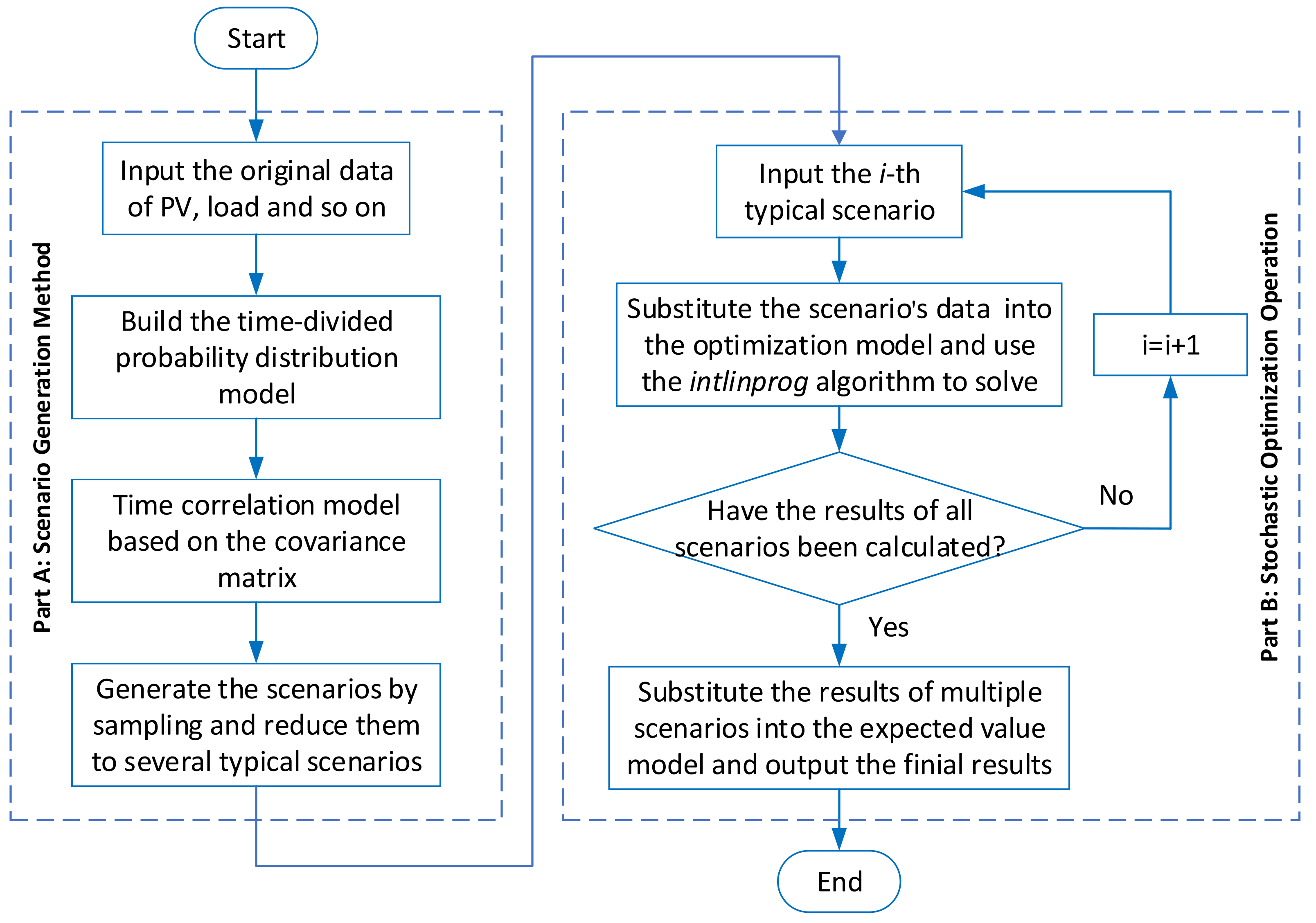


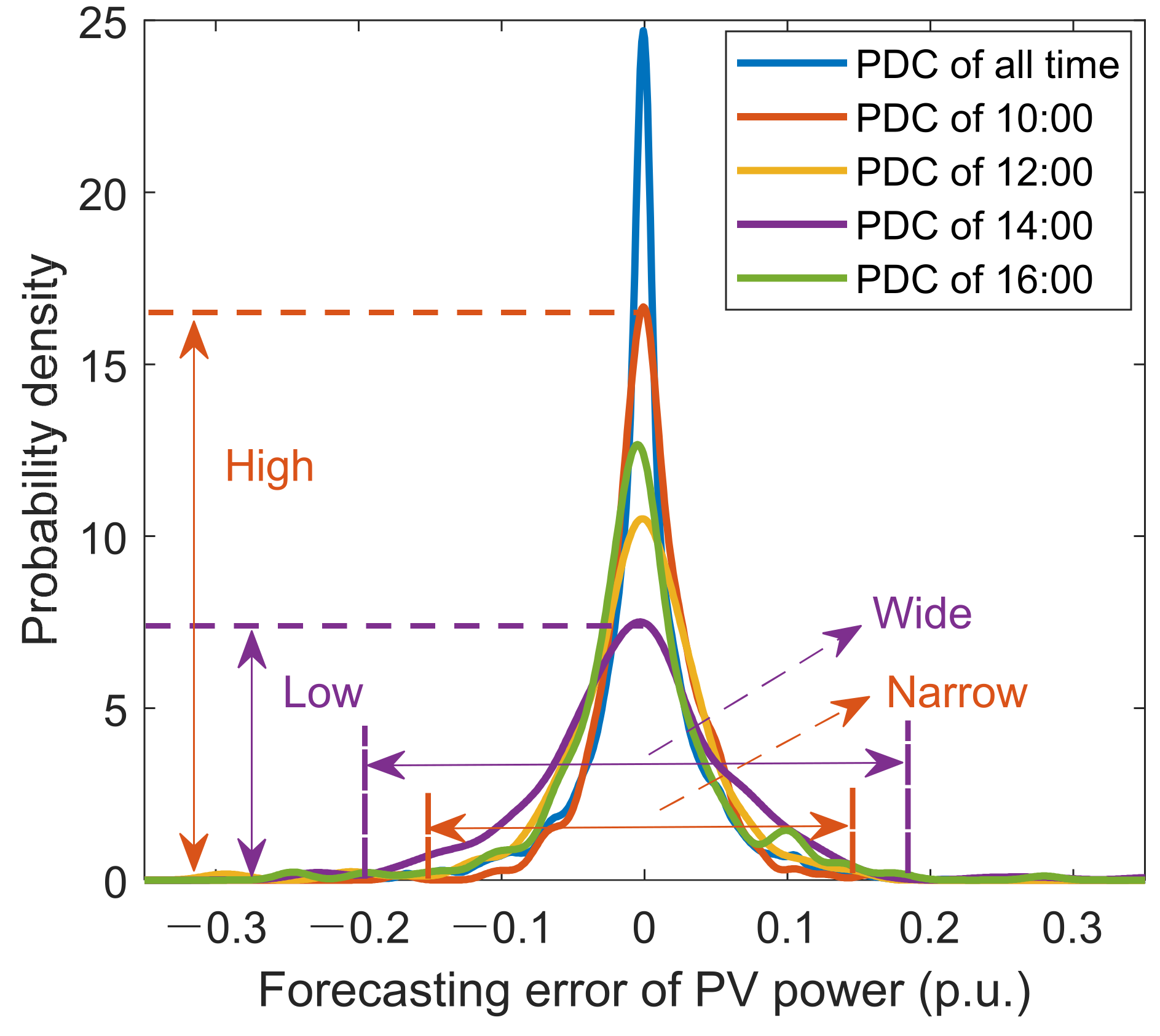

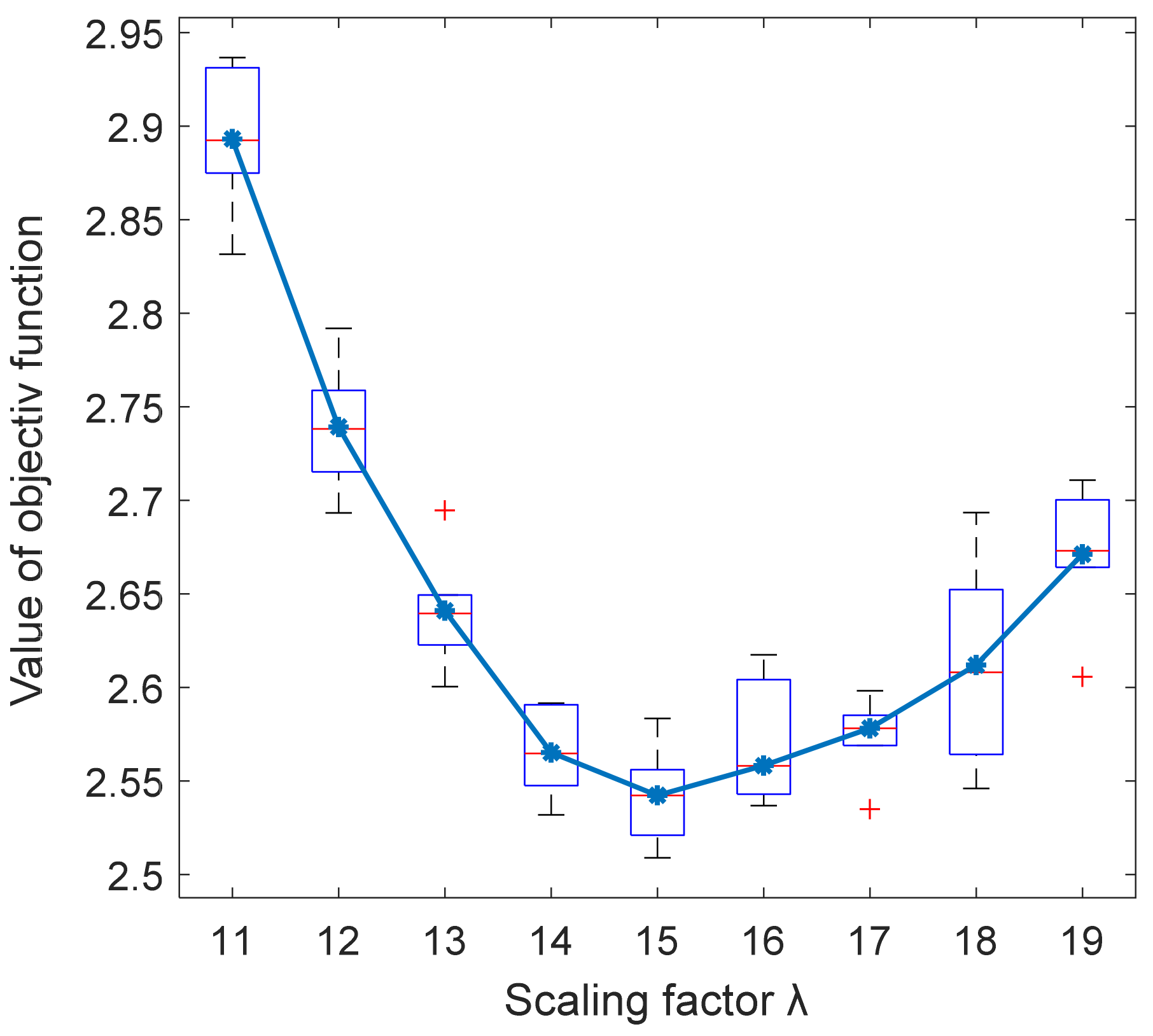
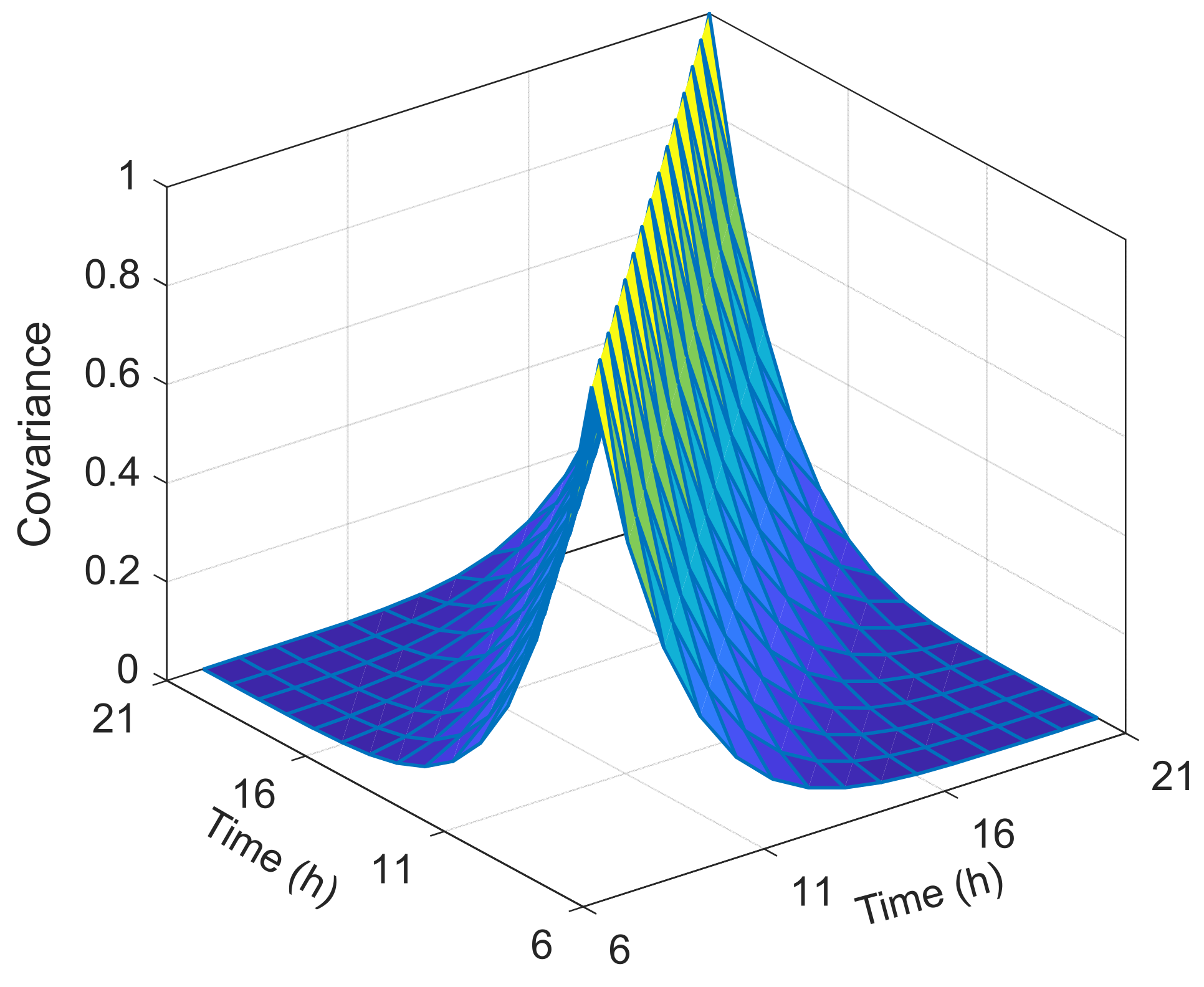
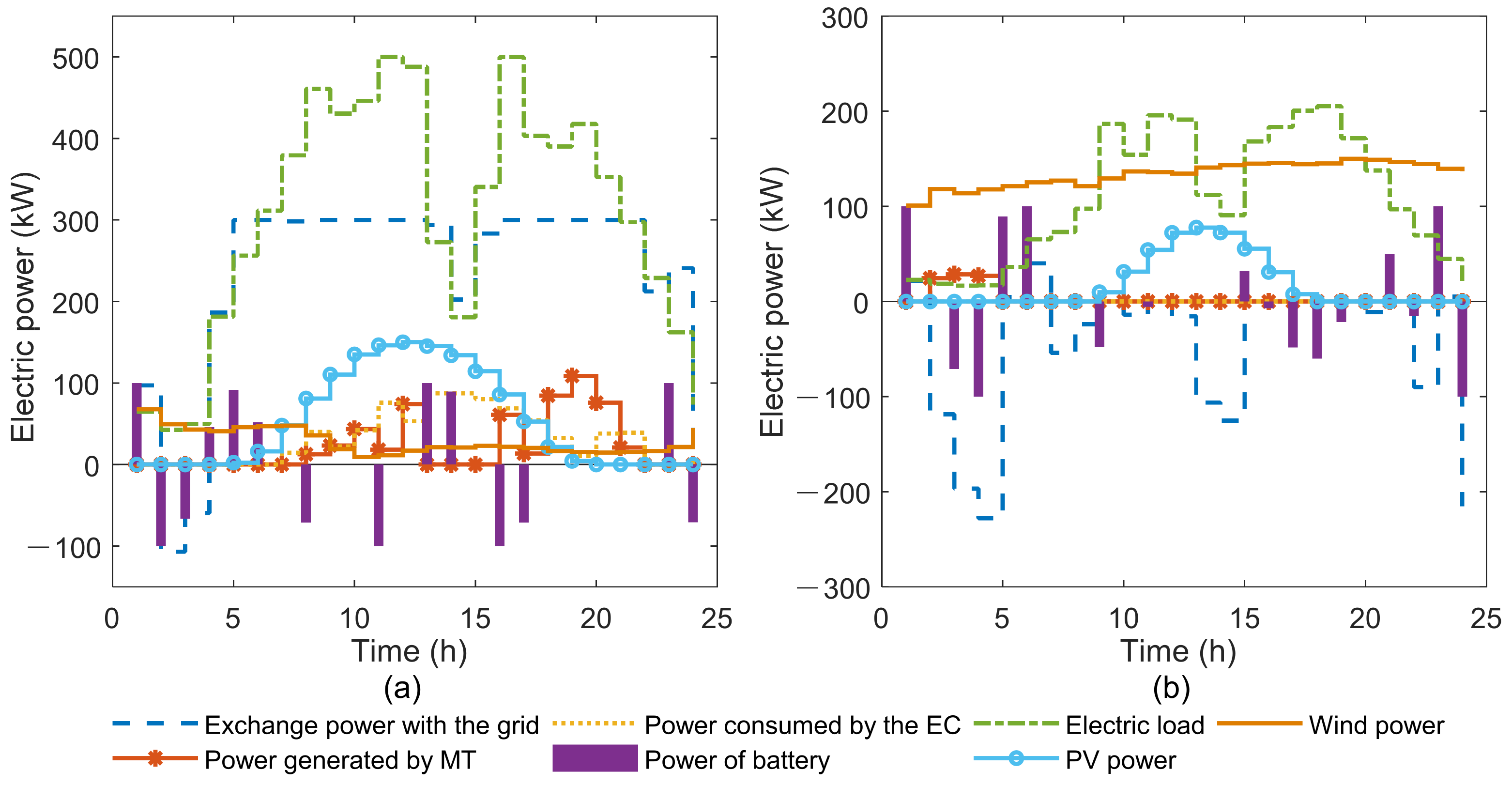
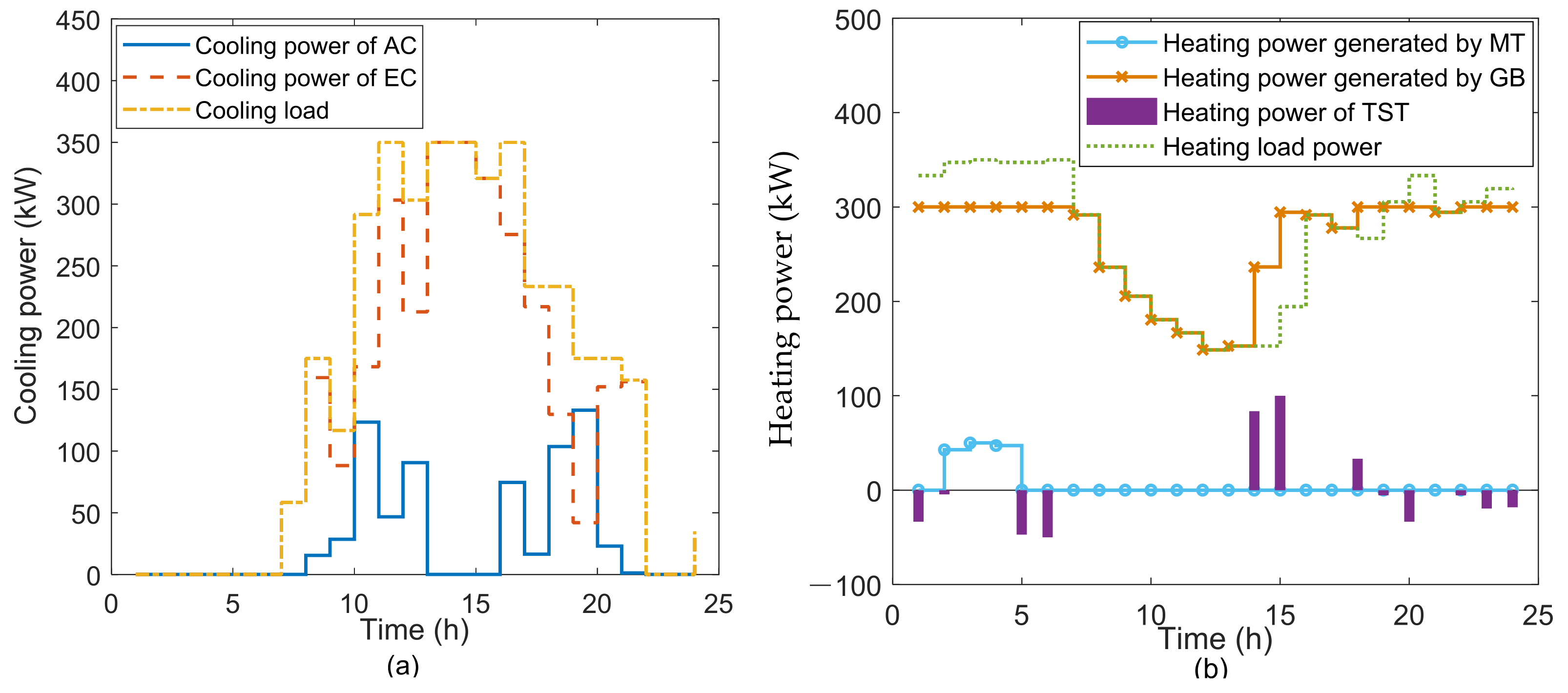
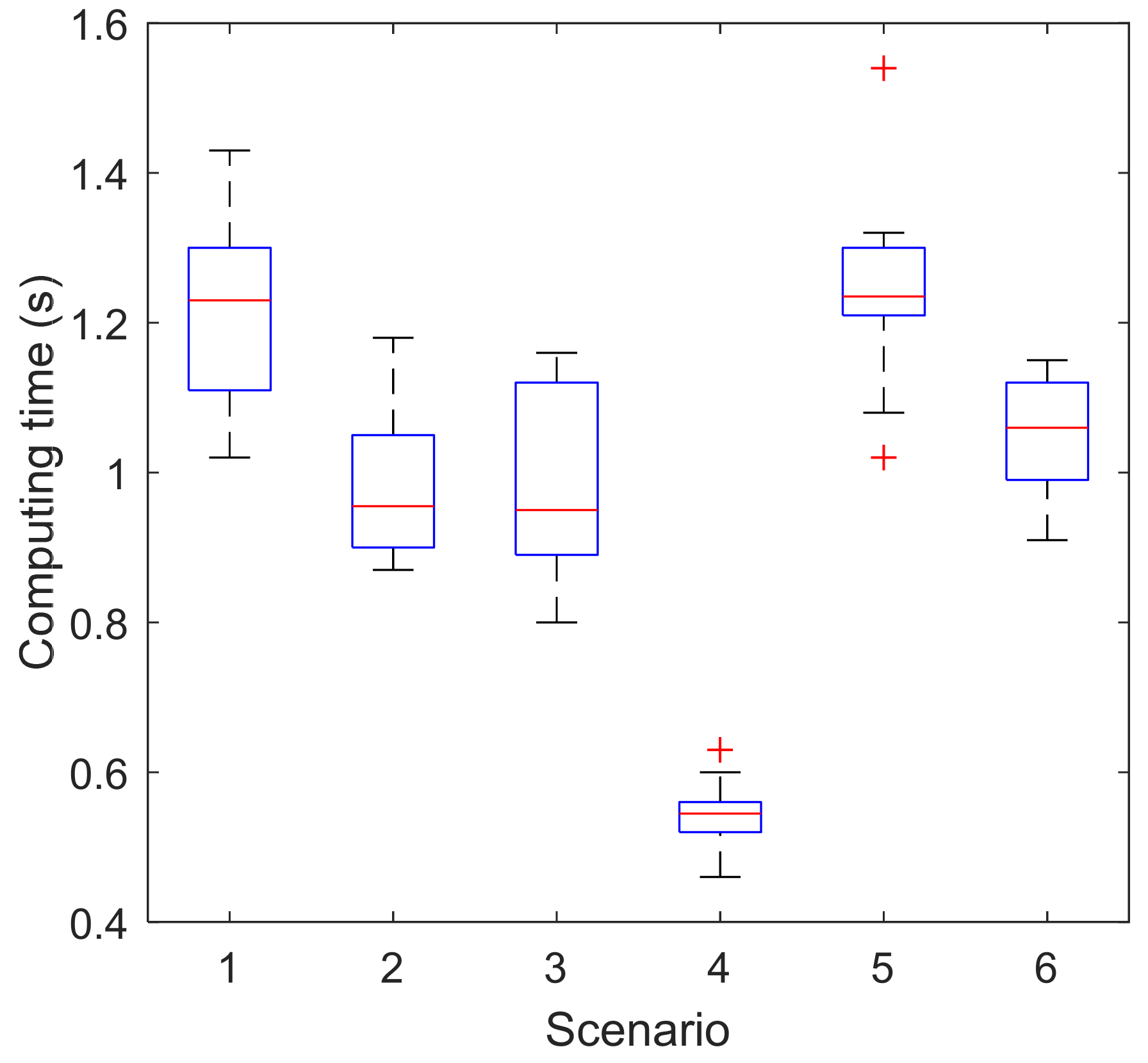
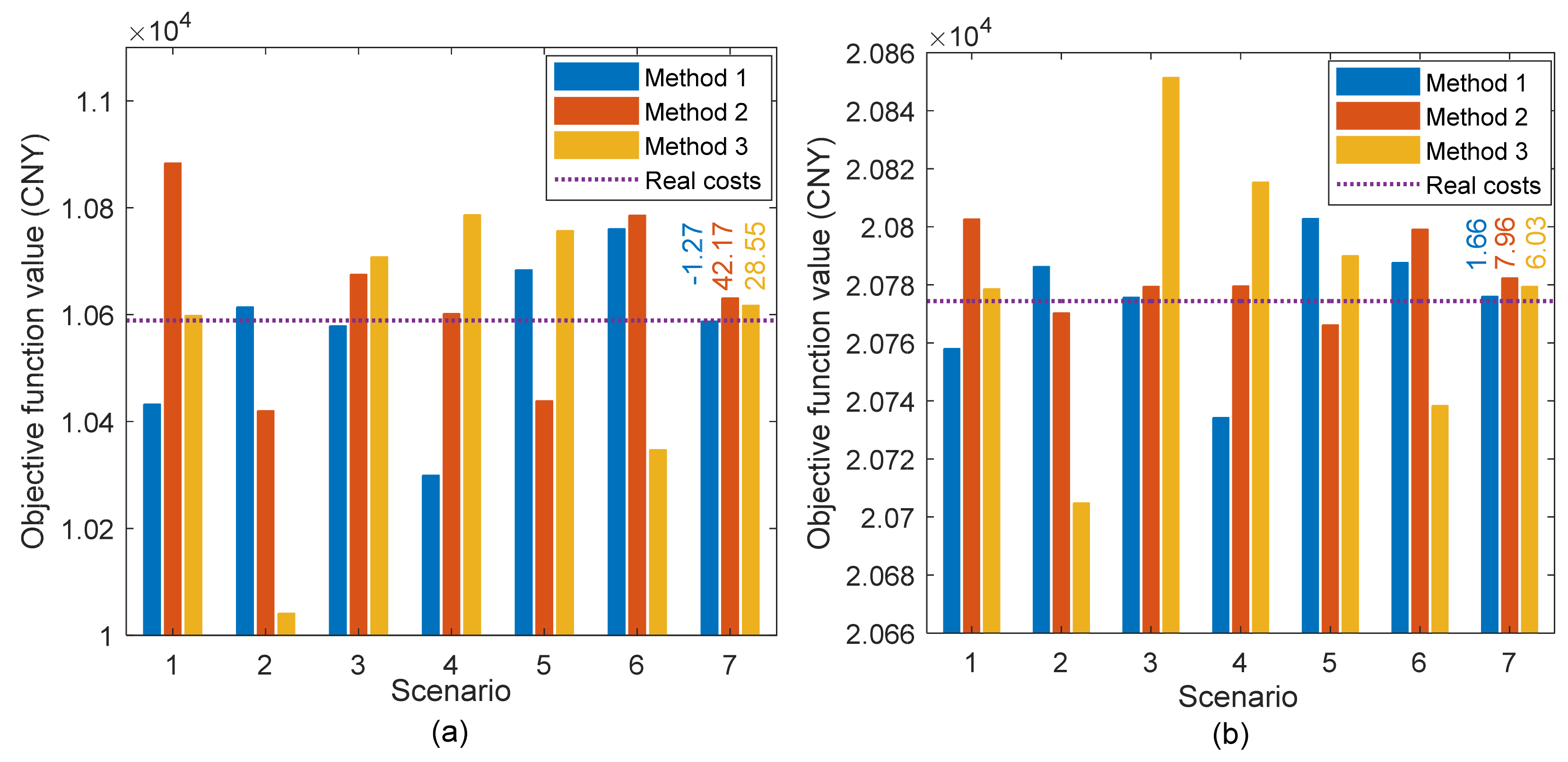
| Equipment | Parameters |
|---|---|
| Gas microturbine | |
| Gas boiler | |
| PV power | |
| Absorption chiller | |
| Electric chiller | |
| Wind power | |
| Battery | , |
| Thermal storage tank | , , |
| Exchange power with grid | |
| Heating exchanger |
Publisher’s Note: MDPI stays neutral with regard to jurisdictional claims in published maps and institutional affiliations. |
© 2022 by the authors. Licensee MDPI, Basel, Switzerland. This article is an open access article distributed under the terms and conditions of the Creative Commons Attribution (CC BY) license (https://creativecommons.org/licenses/by/4.0/).
Share and Cite
Zhang, D.; Jiang, S.; Liu, J.; Wang, L.; Chen, Y.; Xiao, Y.; Jiao, S.; Xie, Y.; Zhang, Y.; Li, M. Stochastic Optimization Operation of the Integrated Energy System Based on a Novel Scenario Generation Method. Processes 2022, 10, 330. https://doi.org/10.3390/pr10020330
Zhang D, Jiang S, Liu J, Wang L, Chen Y, Xiao Y, Jiao S, Xie Y, Zhang Y, Li M. Stochastic Optimization Operation of the Integrated Energy System Based on a Novel Scenario Generation Method. Processes. 2022; 10(2):330. https://doi.org/10.3390/pr10020330
Chicago/Turabian StyleZhang, Delong, Siyu Jiang, Jinxin Liu, Longze Wang, Yongcong Chen, Yuxin Xiao, Shucen Jiao, Yu Xie, Yan Zhang, and Meicheng Li. 2022. "Stochastic Optimization Operation of the Integrated Energy System Based on a Novel Scenario Generation Method" Processes 10, no. 2: 330. https://doi.org/10.3390/pr10020330
APA StyleZhang, D., Jiang, S., Liu, J., Wang, L., Chen, Y., Xiao, Y., Jiao, S., Xie, Y., Zhang, Y., & Li, M. (2022). Stochastic Optimization Operation of the Integrated Energy System Based on a Novel Scenario Generation Method. Processes, 10(2), 330. https://doi.org/10.3390/pr10020330






